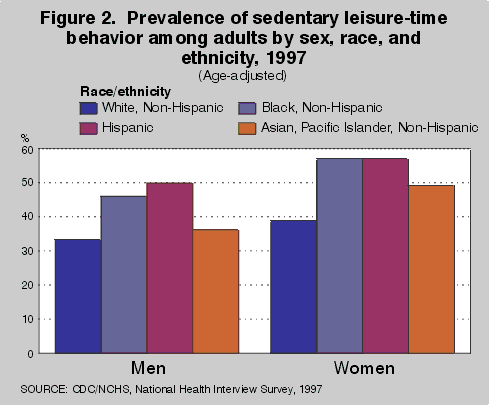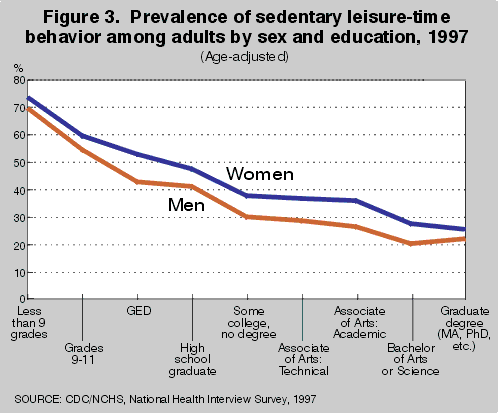Prevalence of Sedentary Leisure-time Behavior Among Adults in the United States
Data from the newly released 1997 National Health Interview Survey show that 4 in 10 U.S. adults say that they NEVER engage in any exercises, sports, or physically active hobbies in their leisure time. Estimates of sedentary behavior shown here are based on responses to a series of questions asking how often and how long respondents engaged in leisure physical activities for at least 20 minutes that caused sweating or changes in their heart rate or breathing. Sedentary behavior has been identified as a risk factor for a variety of chronic health conditions, including coronary heart disease, hypertension, colon cancer, and diabetes mellitus.

About 40% of U.S. adults were sedentary in 1997, engaging in no leisure time physical activities of any kind. Women (43.2%) were somewhat more likely than men (36.5%) to be sedentary, a finding that held in every age group (Figure 1 and Table 1 [PDF – 6 KB]).

Among both men and women, black and Hispanic adults had higher rates of sedentary behavior than white adults (Figure 2 and Table 1 [PDF – 6 KB]).

Leisure time physical activity was also found to be strongly associated with level of education. About 72% of adults who never attended high school were sedentary, declining steadily to 45% among high school graduates and about 24% among adults who had attained graduate level college degrees (Figure 3 and Table 1 [PDF – 6 KB]). These statistics were age-adjusted, thereby eliminating age as an explanation for the observed differences.
The National Health Interview Survey is a survey of the non-institutionalized civilian population, conducted continuously throughout each year. The survey has been conducted since 1957 and underwent a major redesign of its questionnaire and of its data capture instrument in 1997. These findings are the first published from the new design. Physical activity questions were self-reported. Occupation, home, and transportation-related activities are all important contributors to the total picture of physical activity among adults, but due to constraints on the length of the survey these could not be assessed in the 1997 NHIS. For further information see NHIS home page